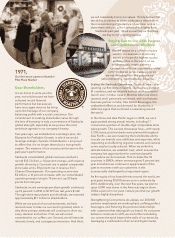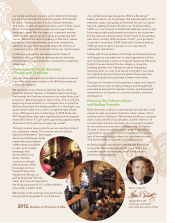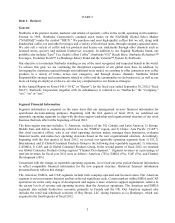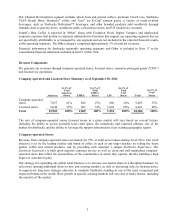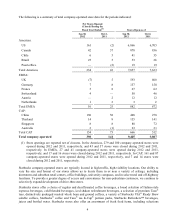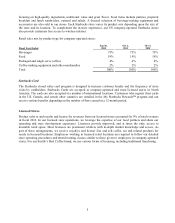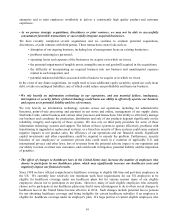Starbucks 2012 Annual Report Download - page 13
Download and view the complete annual report
Please find page 13 of the 2012 Starbucks annual report below. You can navigate through the pages in the report by either clicking on the pages listed below, or by using the keyword search tool below to find specific information within the annual report.7
above the “C” coffee commodity price. Both the premium and the commodity price depend upon the supply and
demand at the time of purchase. Supply and price can be affected by multiple factors in the producing countries,
including weather, natural disasters, crop disease, general increase in farm inputs and costs of production,
inventory levels and political and economic conditions. Price is also impacted by trading activities in the arabica
coffee futures market, including hedge funds and commodity index funds. In addition, green coffee prices have
been affected in the past, and may be affected in the future, by the actions of certain organizations and
associations that have historically attempted to influence prices of green coffee through agreements establishing
export quotas or by restricting coffee supplies.
We buy coffee using fixed-price and price-to-be-fixed purchase commitments, depending on market conditions,
to secure an adequate supply of quality green coffee. Price-to-be-fixed contracts are purchase commitments
whereby the quality, quantity, delivery period, and other negotiated terms are agreed upon, but the date, and
therefore the price, at which the base “C” coffee commodity price component will be fixed has not yet been
established. For these types of contracts, either Starbucks or the seller has the option to select a date on which to
“fix” the base “C” coffee commodity price prior to the delivery date. Until prices are fixed, we estimate the total
cost of these purchase commitments. Total green coffee purchase commitments as of September 30, 2012 were
$854 million, comprised of $557 million under fixed-price contracts and an estimated $297 million under price-
to-be-fixed contracts. As of September 30, 2012, approximately $125 million of our price-to-be-fixed contracts
were effectively fixed through the use of futures contracts. All price-to-be-fixed contracts as of September 30,
2012 were at the Company’s option to fix the base “C” coffee commodity price component. Total purchase
commitments, together with existing inventory, are expected to provide an adequate supply of green coffee
through fiscal 2013.
We depend upon our relationships with coffee producers, outside trading companies and exporters for our
supply of green coffee. We believe, based on relationships established with our suppliers, the risk of non-
delivery on such purchase commitments is remote.
To help ensure sustainability and future supply of high-quality green coffees and to reinforce our leadership role
in the coffee industry, Starbucks operates Farmer Support Centers in six countries. The Farmer Support Centers
are staffed with agronomists and sustainability experts who work with coffee farming communities to promote
best practices in coffee production designed to improve both coffee quality and yields.
In addition to coffee, we also purchase significant amounts of dairy products, particularly fluid milk, to support
the needs of our company-operated stores. For our largest markets, the US, Canada and the UK, we purchase
substantially all of our fluid milk requirements from eight dairy suppliers. We believe, based on relationships
established with these suppliers, that the risk of non-delivery of sufficient fluid milk to support our stores is
remote.
Products other than whole bean coffees and coffee beverages sold in Starbucks stores include Evolution Fresh™
juices and a number of ready-to-drink beverages that are purchased from several specialty suppliers, usually
under long-term supply contracts. Food products, such as pastries, breakfast sandwiches and lunch items, are
purchased from national, regional and local sources. We also purchase a broad range of paper and plastic
products, such as cups and cutlery, from several companies to support the needs of our retail stores as well as
our manufacturing and distribution operations. We believe, based on relationships established with these
suppliers and manufacturers, that the risk of non-delivery of these items is remote.
Competition
Our primary competitors for coffee beverage sales are quick-service restaurants and specialty coffee shops. In
almost all markets in which we do business, there are numerous competitors in the specialty coffee beverage
business. We believe that our customers choose among specialty coffee retailers primarily on the basis of
product quality, service and convenience, as well as price. We continue to experience direct competition from
large competitors in the US quick-service restaurant sector and the US ready-to-drink coffee beverage market.
We also continue to face competition from well-established companies in many international markets.


